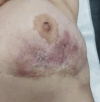Pyoderma Gangrenosum: A Nightmare for Breast Surgery-Two Case Reports
- PMID: 39744929
- PMCID: PMC11706121
- DOI: 10.4274/ejbh.galenos.2024.2024-7-5
Pyoderma Gangrenosum: A Nightmare for Breast Surgery-Two Case Reports
Abstract
Pyoderma gangrenosum (PG) is a rare, chronic, neutrophilic dermatosis characterized by painful ulcers that are often misdiagnosed as wound infections. We report two cases of postsurgical PG following breast surgery: A 46-year-old woman with a non-healing ulcer after a breast biopsy and a 37-year-old woman with wound dehiscence after bilateral reduction mammoplasty. Both cases were initially managed with repeated debridements, antibiotics, and wound care without improvement. The diagnosis of PG was made based on the increase in wound size and irregularity. Treatment with oral doxycycline and topical tacrolimus led to favorable healing within four months. Breast surgical tehniques, which aim to achieve aesthetic results using intraglandular flaps, have become an important part of clinical practice in breast surgery. Early diagnosis and appropriate management are crucial in postsurgical PG to avoid misdiagnosis and ineffective treatments that cause patient disfigurement.
Keywords: Pyoderma gangrenosum; breast surgery; doxycycline; reduction mammoplasty; tacrolimus.
©Copyright 2025 by the Turkish Federation of Breast Diseases Societies / European Journal of Breast Health published by Galenos Publishing House.
Conflict of interest statement
Conflict of Interest: No conflict of interest was declared by the authors.
Figures






Similar articles
-
Early Diagnosis and Treatment of Pyoderma Gangrenosum: Reviewing Mobile Phone Photos Saved a Patient From Unnecessary Surgeries.Cureus. 2024 Feb 23;16(2):e54797. doi: 10.7759/cureus.54797. eCollection 2024 Feb. Cureus. 2024. PMID: 38405660 Free PMC article.
-
Outcomes and Risk Factors of Pyoderma Gangrenosum After Reduction Mammoplasty: A Systematic Review of the Literature and Case Report.Aesthetic Plast Surg. 2025 May 19. doi: 10.1007/s00266-025-04859-z. Online ahead of print. Aesthetic Plast Surg. 2025. PMID: 40389731 Review.
-
Treatment Considerations for Pyoderma Gangrenosum After Reduction Mammoplasty in an Unsuspecting Patient Demographic.Plast Reconstr Surg Glob Open. 2025 Jan 10;13(1):e6448. doi: 10.1097/GOX.0000000000006448. eCollection 2025 Jan. Plast Reconstr Surg Glob Open. 2025. PMID: 39802275 Free PMC article.
-
Management of Idiopathic Pyoderma Gangrenosum With Azathioprine As the Primary Adjunct in an Asian Man: A Case Report.Cureus. 2022 May 21;14(5):e25177. doi: 10.7759/cureus.25177. eCollection 2022 May. Cureus. 2022. PMID: 35746991 Free PMC article.
-
Postoperative Pyoderma Gangrenosum: A Clinical Review of Published Cases.Mayo Clin Proc. 2016 Sep;91(9):1267-79. doi: 10.1016/j.mayocp.2016.05.001. Epub 2016 Jul 31. Mayo Clin Proc. 2016. PMID: 27489052 Review.
References
-
- Esen E, Saydam M, Guler S, Akinci M, Bahcecioglu IB, Gulcelik MA, et al. Successful use of minimal invasive debridement plus negative pressure wound therapy under skin flap and axillary region for refractory postmastectomy seroma: A STROBE-compliant retrospective study. Medicine (Baltimore) 2022;101(43):e31634. doi: 10.1097/md.0000000000031634. - DOI - PMC - PubMed
-
- Haddadin OM, Ortega-Loayza AG, Marzano AV, Davis MDP, Dini V, Dissemond J. An approach to diagnosis and management of patients with pyoderma gangrenosum from an international perspective: results from an expert forum. Arch Dermatol Res. 2024;316:89. - PubMed
LinkOut - more resources
Full Text Sources
